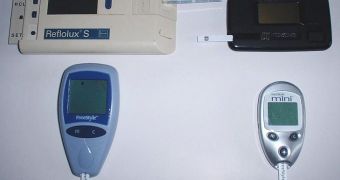Glucose meters – medical devices used for determining the concentration of glucose in blood – can also be used to detect traces of chemicals such as cocaine, proteins such as the pathogen-related molecule interferon, and traces of the radioactive element uranium, a new study shows.
These instruments can also find the essential biochemical adenosine, which is one of the four “letters” DNA is made up of. Interestingly, tests to discover all these elements can be conducted using off-the-shelf glucose meters, without any other modifications.
Findings such as this one are very important because they could change the lives of thousands, if not millions, of people living in developing countries and in the Third World. Often, patients here die because their respective illnesses are not detected in due time.
In order to tune the device so that it can detect these chemicals, researchers at the University of Illinois in Urbana-Champaign (UIUC) modified the chemistry of the blood samples themselves, rather than the glucose meter.
Following these changes, the instrument uses glucose concentrations as proxies on which it bases the detection of other chemicals of interest. The research team that developed the new approach was led by UIUC investigators Yu Xiang and Yi Lu.
“There's an elegant simplicity to their repurposing. The development of a general sensing platform with the convenience and form-factor of the home glucose meter is the holy grail of biosensor research,” comments Kevin Plaxco.
The expert, who holds an appointment as a professor of biochemistry at the University of California in Santa Barbara (UCSB), was not involved in the new research, Technology Review reports.
All that is needed to convert the glucose meters is to mix a solution containing microscopic magnetic beads into the blood sample being analyzed. Each of these beads contains DNA selected specifically to bind to a certain target, such as for example a specific protein.
Alongside the genetic material, the beads also carry on enzyme called invertase, whose role is to break sucrose into glucose. After the blood sample is created, it is left to do its job for several seconds up to several minutes, depending on the chemical researchers are testing for.
Afterwards, an external magnet is used to pull out the remaining magnetic beads, which are laden with intact invertase. When the solution is mixed with another chemical mixture containing sucrose, the enzymes break the stuff down into glucose, which the device can read.
The concentration of glucose is directly related to the concentration of whatever chemical doctors are testing for. This innovation demonstrates that critically-needed technologies can indeed be fashioned into small, cheap, easy-to-use instruments.
“This paper sets an excellent example in combining novel sciences with existing technologies for translational research and development,” University of Florida chemistry professor Weihong Tan says.
“This will revolutionize the field of biosensors and push biosensors to be practically useful in personalized medicine and in medical diagnosis,” concludes the expert, who was not involved in the work.

 14 DAY TRIAL //
14 DAY TRIAL //